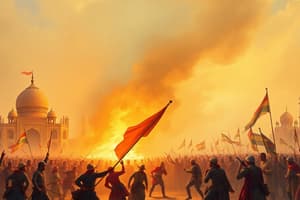Podcast
Questions and Answers
Which of the following was a political cause of the Uprising of 1857?
Which of the following was a political cause of the Uprising of 1857?
- The introduction of the Sati system
- Encouragement of western learning for women
- Employment opportunities for craftsmen
- Dislodgement of native rulers by the British (correct)
The introduction of widow remarriage was a factor that led to discontent among the people during the Uprising of 1857.
The introduction of widow remarriage was a factor that led to discontent among the people during the Uprising of 1857.
False (B)
What was the condition of the peasantry in Awadh before the Uprising of 1857?
What was the condition of the peasantry in Awadh before the Uprising of 1857?
The peasantry suffered heavily as they had to pay very high land revenues.
The British annexed the territories of many Indian rulers, which led to the _______ of their power.
The British annexed the territories of many Indian rulers, which led to the _______ of their power.
Match the following causes of the Uprising of 1857 with their descriptions:
Match the following causes of the Uprising of 1857 with their descriptions:
Flashcards are hidden until you start studying
Study Notes
Causes of the Revolt
Political Causes
- British land revenue policies diminished the authority of Indian rulers.
- Annexation of territories from numerous Indian rulers by the British.
- Discontinuation of pensions and titles for many deposed rulers.
- Native rulers like Nana Saheb and Rani Lakshmibai were removed under allegations of misgovernance.
Awadh Context
- Awadh was manipulated as a puppet state under British control.
- The Nawab of Awadh was deposed and moved to Calcutta.
- Exploitation led to widespread dissatisfaction among the Awadhi people.
- The British drained Awadh's wealth, impacting peasantry and traditional craftsmen.
- Disbanded soldiers faced unemployment; the aristocracy lost its privileges.
Social and Religious Causes
- Abolishment of the Sati practice sparked resentment among Hindus.
- British laws intended to improve women's rights, such as widow remarriage.
- Racial discrimination led Indians to occupy inferior positions in civil services.
- Restrictions on travel for Indians, along with support for Christian missionary activities, fueled discontent.
Key Events Leading to the Revolt
Dethroning of Nawab Wajid Ali Shah
- Nawab Wajid Ali Shah was deposed for alleged misgovernance and disloyalty.
- His rule was a buffer for British interests in Awadh.
Exploitation of Awadh
- British policies heavily exploited local resources and people.
- Traditional lifestyles were replaced, leading to increased unemployment.
- British goods undercut traditional Indian industries due to unfair taxation.
Immediate Causes of the Revolt
- Introduction of the Enfield Rifle sparked outrage due to its pig and cow fat cartridge.
- Mangal Pandey became the first martyr of the revolt by attacking his superiors in March 1857.
- His execution incited widespread unrest among sepoys, leading to rebellion.
Outbreak and Spread of the Revolt
- 85 sepoys at Meerut refused to use Enfield cartridges, instigating mass resistance.
- On May 10, 1857, sepoys in Meerut unleashed violence against British officers and property.
- The revolt escalated as sepoys marched to Delhi, declaring Bahadur Shah Zafar as the Emperor.
Main Centers and Leaders of the Revolt
- Kanpur: Led by Nana Saheb, who proclaimed himself Peshwa with support from Tantia Tope and Azimullah.
- Awadh (Lucknow): Led by Begum Hazrat Mahal with significant support from local peasants and chiefs.
- Bareilly: Led by Khan Bahadur Khan; the uprising occurred on May 31, 1857.
- Jhansi: Rani Lakshmi Bai emerged as a prominent leader against British annexation.
Reasons for the Revolt's Failure
- The revolt did not gain support from critical regions like Rajasthan, Assam, and parts of Punjab.
- Many Indian rulers remained loyal to the British, undermining the unity of the revolt.
- Limited geographical spread contributed to the failure of the uprising.
Effects of the Uprising
- Shift in British policy aimed at consolidating power and preventing further revolts.
- Transfer of control from the East India Company to the British Crown via new parliamentary act in 1858.
- Appointment of a Secretary of State for Indian Affairs to oversee British governance in India, marking a significant administrative transition.
Global Context
- The Taiping Rebellion in China around the same time sought to establish a Christian-based society, opposing traditional practices.
- The rebellion was quashed by the Qing dynasty with assistance from British and French forces.
Key Takeaways
- The Revolt of 1857 was fueled by socio-political and economic grievances against British rule.
- The uprising showcased resistance across various Indian regions, reflecting deep-rooted discontent.
- It led to significant changes in British colonial administration in India.
Studying That Suits You
Use AI to generate personalized quizzes and flashcards to suit your learning preferences.




